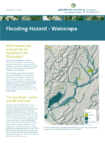-
WTSM 2001 TN19_1 Time Period
The demand models (trip end, distribution and mode choice) produce 24 hour person trip matrices by purpose and mode in production/attraction form (trips are ‘produced’ at home and ‘attracted’ to…
alarm Published 31 Jul 2003 -
WTSM 2001 TN16_1 Trip End
This paper describes the calibration of the trip end models (productions and attractions) for the purposes:
Home Based Work (HBW)
Home Based Education (HBEd)
Home Based Shopping (HBSh) - including personal business
Home Based…alarm Published 31 Jul 2003 -
WTSM 2001 TN17_1 Distribution and Model
The WTSM trip distribution and mode choice models estimate the trip matrices by mode and purpose from the trip ends and network generalised costs. They have been calibrated as 24…
alarm Published 31 Jul 2003 -
Transport Futures - July 2003
This edition includes:
Updated Benefit Cost Ratio for Transmission Gully
Regional Land Transport Committee - Summary of 29 May 2003
Meeting Held at Porirua City Councilalarm Published 01 Jul 2003 -
Save the Drain for Rain
In urban areas, the pipes that collect rainwater from your
roof and yard are connected to a network of underground
pipes that transfer the rainwater to local streams or to the
seashore. These…alarm Published 19 Jun 2003 -
Save the Drain for Rain
Save the Drain for Rain is a pamphet that explains the
difference between the stormwater network and sewage
system. It describes common house hold wastes that
are often unintentionally disposed…alarm Published 02 Jun 2003 -
Inanga Spawning Habitats in the Wellington Region - Part 2 - Wairarapa
This report surveys the Inanga spawning habitats in the
Wairarapa, being the eastern districts of the Wellington Region,
and delivers the results of this study.alarm Published 02 Jun 2003 -
Flooding Hazard - Wairarapa
An information sheet describing the flood hazards of
Wairarapa. Including the places most at risk from a
big flood, the chances of a big flood occurring, a big…alarm Published 01 Jun 2003 -
Paleoseismic assessment of the active Mokonui Fault, Wairarapa
Purpose to investigate the earthquake history and fault characteristics of the Mokonui Fault near Masterton to inform hazard assessments.
alarm Published 01 Jun 2003

